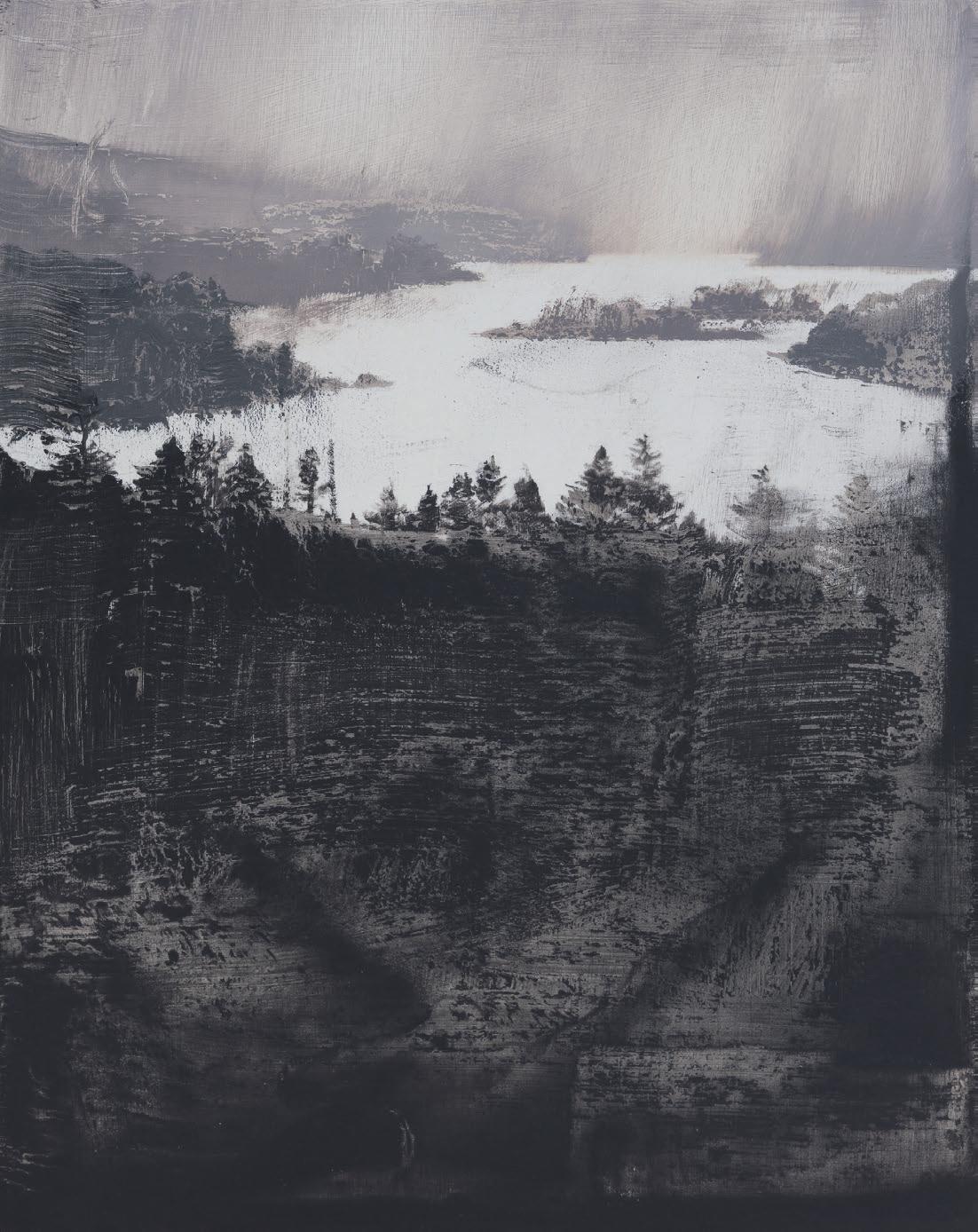
5 minute read
declutt er during lockdown
Pensive Isolation
DAVID SMITH TRACES THE IMPACT OF SOLITUDE WITHIN HIS PAINTING PRACTICE.
David Smith, Wooded lake – dusk gradient, 2020, oil on birch ply, 28 × 35.5 cm; all images courtesy of the artist
TRADITIONALLY, MANY ARTISTS dream of isolation. The poetic, romantic kind of solitude found in distant residencies, with nothing but an enriching bleakness to help us dig deeper into our work. A place where previously hidden motivations and inspirations reveal themselves, allowing new qualities and questions to feed one’s process. This is not that. This is a kind of isolation nobody expected. This is the non-hugging type, with internet overload, fear of statistics and the low, constant hum of unease.
Isolation is a very visible theme in my work. I lived in Hong Kong for 11 years in one of the most densely populated areas on the planet. I know exactly what it is to dream hard of sweet, romantic isolation. My first apartment over there in 2005 was the size of my current bathroom, and I stayed there for 7 months. My landscape paintings became much more focused after being pushed through the lenses of confinement and intensity. External pressures like work culture, extreme volumes of people, heat, noise, air pollution, and relentless sensory overload, came to bear on how I made paintings. They began to reflect a kind of looking for a clearing within a dense environment, compromised by human presence and activities.
My current studio is a home studio, meaning I don’t have access problems that many artists are currently trying to adjust to. I’ve always found it to be a good working scenario. At one point in Hong Kong, I had a small home studio and a relatively large one at the other end of the city. However, at that time I worked almost exclusively on a small scale, so my home studio, looking out on towering apartment blocks with little sky, saw most of the action. I sometimes hesitate to call myself a landscape painter, as I don’t go out and paint what I see exactly. What tends to happen is I collect experiences, memories, impressions, photographs and sketches from everywhere I have been, and work from these shifting and growing sources. An image of a location in Hong Kong that I ignored for years may suddenly seem vital and hold a quality that resonates. This may become a starting point, leading into a new avenues to be explored. The same may happen
David Smith, Lake islands – winter light, 2020, oil on birch ply, 20 × 25 cm

with sketches I made in the deserts of Jordan, many years ago on a residency, or with more recent sketches and photographs I made around my local area, within the 5km travel restrictions. Time, distance and location all converge on the present moment of painting. I’ve become more aware of an underlying motivation or hope for a new sublime to emerge from the natural world and our destructive interactions within it. Romantic notions seen through the silvery grey haze of a Hong Kong skyline.
Our current lockdown scenario in Ireland has been a strange experience from an artist’s point of view. Conversations I’ve had with artist friends have revealed an initial self-pressure to produce work. Now that there’s time, make, make, make, go, go, go. It’s like a t-shirt I saw in Asia printed with the phrase “Always Go Always Do” – a perfect summation of Hong Kong, but also a frightening prospect. This self-pressure is like a hangover from the past. I’ve felt and continue to feel this pressure myself, but recently decided to forgive myself for a certain amount of inactivity. What I’ve found happening is I’ve explored other mediums that lay dor
David Smith, Cold lake – winter showers, 2019, oil on birch ply, 25 × 20 cm

mant for a while. I’ve grown up playing music, and in the last ten years, have also dug more into photography. These explorations are more playful and have provided a nice contrast for investigation recently, and actually have a vital feedback effect on my usual studio practice, helping to renew and refresh it – although as I type ‘usual’, I’m struggling to actually define it.
Right now, I’d probably describe my studio practice as a funky mix of focus, vagueness, intense activity, worry and feelings of wanting to get away from it. This might be familiar for anyone also working in arts education. Everyone initially scrambled to become experts in Zoom, Loom, Microsoft Teams, Moodle, Noodle and Doodle. And while there is an initial novelty to living and working virtually, it certainly can’t replace tactile experiences, social interaction and navigating physical material and space. However, I’m a big believer in limitations being a great primer for creative action and growth. This period has also reminded me of the essential importance of play. It’s easy to get stuck making somewhat accomplished things to continue your “studio output”. But I feel the need and desire to step back and rediscover the essential joy of materials, of unexpected colour, of the space between notes, of beautiful photographic overexposure, of unfamiliar media and a thousand other creative joys yet to be discovered or rediscovered.
Just before lockdown I had sent a large batch of work to a gallery in Europe that was due to be shown at one of the art fairs. Most of these events have all been cancelled, altered or postponed. Artists of all disciplines have had events, gigs and paid work suddenly disappear. This financial instability is not the good type of limitation – it’s the threat of what the future might or might not hold. I do truly hope that our ways of living on this precious and unique little blue ball can change. They desperately need to. This is not romantic isolation, but it might be a necessary breath.










